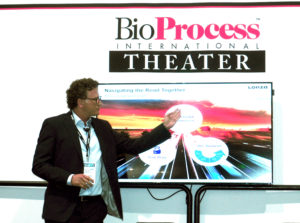 Presented by Cyril Peter (senior proposal manager, Lonza Pharma and Biotech) 1:00–1:20 pm
Presented by Cyril Peter (senior proposal manager, Lonza Pharma and Biotech) 1:00–1:20 pm
A publicly traded company, Lonza focuses on drug sponsors that want to go to market with their own products. “To get there, you need to make a drug out of your molecule, manufacture it, go through clinical trials, and generate data for submission to regulatory authorities for market authorization.” That requires information about the molecule (critical quality attributes, CQAs) and on how you make it (critical process parameters, CPPs). If you work with a contract development and manufacturing organization (CDMO), those items also help set roles and responsibilities each company will have. A drug sponsor (market authorization holder) owns the knowledge on safety, identity, efficacy, and quality — including identity, purity, and biological activity. A CDMO owns the manufacturing process and provides the evidence of its suitability along with that of analytical methods and equipment used. Regulatory documents make clear that CDMOs are extensions of sponsor organizations and that both are considered accountable when it comes to market authorization.
Peter said that Lonza wants to travel with its clients to a successful submission together. To regulatory authorities, that means providing documented evidence to demonstrate process understanding and performance. When a drug is on the market, a reliable maintenance system must maintain both drug and process throughout the lifecycle. Lonza can help clients plan what needs to be done to get to regulatory submission: process development, risk assessment, defining CPPs through process characterization, process evaluation and necessary studies, analytical validation, and performance qualification. After market entry, the company helps with ongoing process verification.
Process characterization is an example of how elaborate planning can be. Peter described the stages of process understanding to move from a wide range of possible parameters to a defined design space: Starting with possible process parameters, a risk assessment leads to potential CPPs. The elaborate exercise of process characterization identifies the truly critical process parameters. And together with the defined limits, CPPs will define a design space.
To navigate that complex road, Lonza has established a five-step pre-BLA (biologics license application) program: defining what you want to do and establish time lines (set the frame); determining what is needed to get to the BLA and defining the scope of risk assessment; assessing risk to prepare clients for the trip by focusing on critical items; defining the stages of process engineering; and executing a project.
By the end of 2016, the company had supported more than 250 clinical programs (>190 large molecules and 60 small molecules). More than 50 products are commercial medicines supplied by Lonza covering a broad range of processes and therapeutic modalities. The company can accommodate accelerated approvals (e.g., breakthrough therapies). Lonza has been involved with 38% of biologics approved since 2011. This experience provides clients with high-quality cost-of-goods (CoG) benefits and fast project completion to benefit patients through commercial success.
The company’s vision is to “deliver the medicines of tomorrow today.” It is located on three continents at 15 sites covering seven product modalities and technologies — including research, process development, and manufacturing services. Having generated sales of 4.1 billion Swiss francs in 2016 alone, the company has been providing services since 1897.
Questions and Answers
Do you cover fill–finish operations and testing? “Yes, fill–finish is part of our service package. So are testing analytics (e.g., release testing). Our area for drug products has three pillars: formulation development, fill-and-finish, and primary packaging. Final testing is part of that.”
Do you work with antibody drug conjugates (ADCs)? Covered therapeutic modalities include small molecules, large biomolecules, and the use of mammalian and microbial expression systems. “We do ADCs, cell therapies, and viral therapies.”
